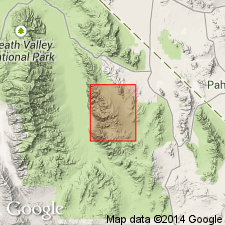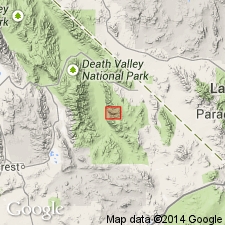
- Usage in publication:
-
- Copper Canyon formation*
- Modifications:
-
- Named
- Biostratigraphic dating
- Dominant lithology:
-
- Conglomerate
- Siltstone
- Basalt
- Evaporite
- AAPG geologic province:
-
- Great Basin province
Summary:
Named for Copper Canyon area near Death Valley National Monument. Type area is basin of Copper Canyon, Funeral Peak 15' quad, Inyo Co, CA. Sequence informally referred to as Copper Canyon beds (Curry, 1941, Geological Society of America Bulletin, v. 52, no. 12, pt. 2). Is sequence of moderate red conglomerate, yellowish-gray siltstone and evaporites and intercalated basalt. Thickness ranges from 7,000 ft to 10,000 ft. Unconformably overlies tuffaceous rocks and is faulted against intrusive felsite of older volcanic rocks along north side of basin. Unconformably underlies conglomerate of Funeral formation to the east. Age is accepted as Pliocene(?) on basis of report by Curry (1941).
Source: GNU records (USGS DDS-6; Menlo GNULEX).

- Usage in publication:
-
- Copper Canyon Formation*
- Modifications:
-
- Age modified
- Geochronologic dating
- AAPG geologic province:
-
- Great Basin province
Summary:
Age of the Copper Canyon Formation is revised from Pliocene(?) to: late Miocene and early Pliocene based on isotopic dating.
Source: GNU records (USGS DDS-6; Menlo GNULEX).
For more information, please contact Nancy Stamm, Geologic Names Committee Secretary.
Asterisk (*) indicates published by U.S. Geological Survey authors.
"No current usage" (†) implies that a name has been abandoned or has fallen into disuse. Former usage and, if known, replacement name given in parentheses ( ).
Slash (/) indicates name conflicts with nomenclatural guidelines (CSN, 1933; ACSN, 1961, 1970; NACSN, 1983, 2005, 2021). May be explained within brackets ([ ]).

